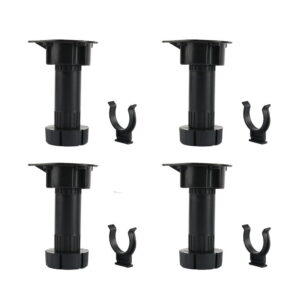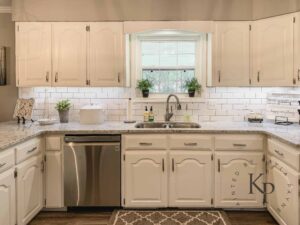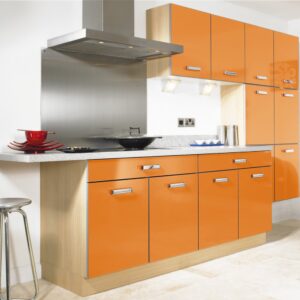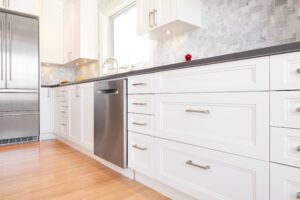When it comes to kitchen renovations, homeowners are constantly seeking ways to add character and charm to their space. One popular and timeless option is to incorporate beadboard into kitchen cabinets. Beadboard is a type of paneling that features narrow, vertical planks with rounded edges, creating a distinctive look that adds texture and visual interest to any room. In this article, we will explore the benefits of adding beadboard to kitchen cabinets, discuss various installation methods, and provide tips on how to maintain and care for beadboard. Whether you prefer a traditional farmhouse aesthetic or a modern coastal vibe, beadboard can transform your kitchen cabinets into a stylish focal point.
The Benefits of Beadboard
Before diving into the installation process, let’s first examine the numerous advantages of incorporating beadboard into your kitchen cabinets:
- Enhances the aesthetics: Beadboard instantly adds visual interest and texture to your kitchen cabinets, creating a charming and inviting atmosphere. It can complement a variety of design styles, from traditional to contemporary.
- Cost-effective: Compared to other kitchen cabinet upgrades, adding beadboard is a relatively affordable option. It offers a high-end look without breaking the bank.
- Easy installation: Beadboard is relatively easy to install, especially if you opt for pre-made beadboard panels. This makes it an ideal choice for DIY enthusiasts who want to tackle a kitchen renovation project.
- Durable and long-lasting: The inherent strength of beadboard makes it highly durable, ensuring that your kitchen cabinets will withstand the test of time. It can also resist moisture and humidity, which is crucial in a kitchen environment.
Methods of Adding Beadboard to Kitchen Cabinets
There are several methods to incorporate beadboard into kitchen cabinets, each with its own unique advantages and considerations. Let’s explore the most popular approaches:
1. Full Overlay Method
The full overlay method involves covering the entire cabinet door with beadboard, creating a seamless and cohesive look. This method is best suited for homeowners who prefer a more traditional or cottage-style kitchen aesthetic. Here’s a step-by-step guide to achieving the full overlay look:
- Remove the cabinet doors: Start by unscrewing the cabinet doors from the hinges and carefully place them in a safe area.
- Measure and cut the beadboard: Measure the dimensions of each cabinet door and use those measurements to cut the beadboard panels accordingly. Ensure that the panels fit snugly on the doors without any gaps.
- Apply adhesive: Apply a generous amount of construction adhesive to the back of the beadboard panels, ensuring complete coverage.
- Attach the beadboard: Press the beadboard panels firmly onto the cabinet doors, smoothing out any air bubbles or wrinkles. Use clamps or weights to hold the panels in place until the adhesive dries.
- Reattach the cabinet doors: Once the adhesive is fully dry, reattach the cabinet doors to the hinges. Ensure that they are properly aligned and level.
- Finishing touches: Fill any visible seams or gaps with wood filler, then sand and paint the cabinets to your desired color.
2. Partial Overlay Method
The partial overlay method involves applying beadboard to only a portion of the cabinet door, leaving a border of the original material exposed. This method offers a more contemporary and subtle look, making it suitable for homeowners who prefer a modern or transitional kitchen style. Here’s how to achieve the partial overlay look:
- Remove the cabinet doors: Begin by removing the cabinet doors from the hinges and setting them aside.
- Measure and mark the desired area: Use a measuring tape and pencil to mark the area on the cabinet door where you want the beadboard to be applied. Ensure that the markings are symmetrical and level.
- Cut the beadboard: Measure and cut the beadboard panels to fit within the marked area on the cabinet door. It’s crucial to double-check the measurements to ensure a precise fit.
- Apply adhesive: Apply construction adhesive to the back of the beadboard panels, focusing on the areas where they will be attached to the cabinet door.
- Attach the beadboard: Press the beadboard panels onto the marked area of the cabinet door, making sure they are aligned and level. Use clamps or weights to hold the panels in place until the adhesive dries.
- Reattach the cabinet doors: Once the adhesive has dried, reattach the cabinet doors to the hinges, ensuring they are properly aligned and level.
- Final touches: Fill any visible seams or gaps with wood filler, then sand and paint the cabinets to your desired color.
3. Beadboard Wallpaper Method
If you’re looking for a quick and easy way to add beadboard texture to your kitchen cabinets, beadboard wallpaper is an excellent alternative. This method requires minimal effort and is perfect for renters or those on a tight budget. Here’s a simple guide to applying beadboard wallpaper:
- Clean the cabinet doors: Begin by thoroughly cleaning the surface of the cabinet doors to ensure that the wallpaper adheres properly.
- Measure and cut the wallpaper: Measure the dimensions of each cabinet door and cut the beadboard wallpaper accordingly. Leave a few extra inches on each side to ensure a precise fit.
- Apply wallpaper adhesive: Apply a thin layer of wallpaper adhesive to the back of the beadboard wallpaper, ensuring complete coverage.
- Attach the wallpaper: Carefully place the beadboard wallpaper onto the cabinet door, smoothing out any air bubbles or wrinkles. Use a wallpaper smoothing tool or a squeegee to ensure a tight and secure bond.
- Trim the excess wallpaper: Use a sharp utility knife to trim off any excess wallpaper along the edges of the cabinet door for a clean finish.
- Repeat for all cabinet doors: Repeat the process for each cabinet door, ensuring that the beadboard wallpaper is applied evenly and seamlessly.
Maintaining Beadboard Cabinets
Once you’ve successfully added beadboard to your kitchen cabinets, it’s essential to maintain and care for them properly to ensure their longevity. Here are some tips for maintaining beadboard cabinets:
- Regular cleaning: Wipe down the beadboard regularly with a damp cloth or sponge to remove any dust or dirt. Avoid using harsh chemicals or abrasive cleaners, as they may damage the finish.
- Avoid excessive moisture: Beadboard is relatively moisture-resistant, but it’s still important to avoid excessive moisture and humidity in the kitchen. Wipe up any spills promptly and ensure proper ventilation in the area.
- Gentle cleaning techniques: If stains or stubborn dirt persist, use a mild soap solution and a soft-bristle brush to gently scrub the affected areas. Rinse thoroughly and dry with a clean cloth.
- Avoid sharp objects: Beadboard can be prone to scratches and dents, so it’s important to avoid using sharp objects or abrasive materials when cleaning.
- Periodic inspections: Regularly inspect the beadboard for any signs of damage, such as cracks, peeling, or warping. Address any issues promptly to prevent further deterioration.
FAQs About Adding Beadboard to Kitchen Cabinets
1. Can I add beadboard to my existing kitchen cabinets?
Yes, you can add beadboard to your existing kitchen cabinets. It’s a popular and relatively straightforward DIY project that can instantly transform the look of your kitchen.
2. What type of beadboard is best for kitchen cabinets?
When choosing beadboard for your kitchen cabinets, opt for moisture-resistant materials such as PVC or MDF. These materials are more durable and better suited for the kitchen environment.
3. Can I paint beadboard cabinets?
Yes, you can paint beadboard cabinets to match your desired color scheme. Make sure to use a high-quality paint that is suitable for the kitchen area and properly prepare the surface before painting.
4. How long does beadboard installation take?
The duration of beadboard installation depends on the size of your kitchen and the chosen installation method. On average, it can take anywhere from a few days to a week to complete the project.
5. Can I install beadboard on my own?
Yes, installing beadboard on your kitchen cabinets can be a DIY project. However, it’s essential to have basic carpentry skills and the necessary tools to ensure a successful installation.
In Conclusion
Adding beadboard to kitchen cabinets is a fantastic way to elevate the overall aesthetics of your space. Whether you opt for the full overlay, partial overlay, or beadboard wallpaper method, this timeless upgrade will bring charm and character to your kitchen. Remember to maintain your beadboard cabinets properly, and they will continue to impress foryears to come. With its affordable cost, easy installation, and durability, beadboard is a practical choice for homeowners looking to revamp their kitchen cabinets. By following the provided installation methods and maintenance tips, you can achieve a beautiful and functional kitchen space that reflects your personal style.
In summary, beadboard is a versatile and charming addition to kitchen cabinets. Its ability to add texture, enhance aesthetics, and provide a cost-effective solution makes it a popular choice among homeowners. Whether you prefer a traditional farmhouse look or a modern coastal vibe, beadboard can transform your kitchen cabinets into a stylish focal point. With the various installation methods available, you can customize the level of beadboard coverage to suit your design preferences. Remember to maintain and care for your beadboard cabinets properly to ensure their longevity and continued beauty.
FAQs After The Conclusion:
1. Can I add beadboard to my existing kitchen cabinets?2. What type of beadboard is best for kitchen cabinets?3. Can I paint beadboard cabinets?4. How long does beadboard installation take?5. Can I install beadboard on my own?
Incorporating beadboard into your kitchen cabinets is a rewarding project that can significantly enhance the overall look and feel of your kitchen. Whether you choose to embrace a traditional or contemporary style, the addition of beadboard will bring charm and character to your space. So, why wait? Start planning your beadboard cabinet upgrade today and enjoy the timeless beauty it brings to your kitchen.





